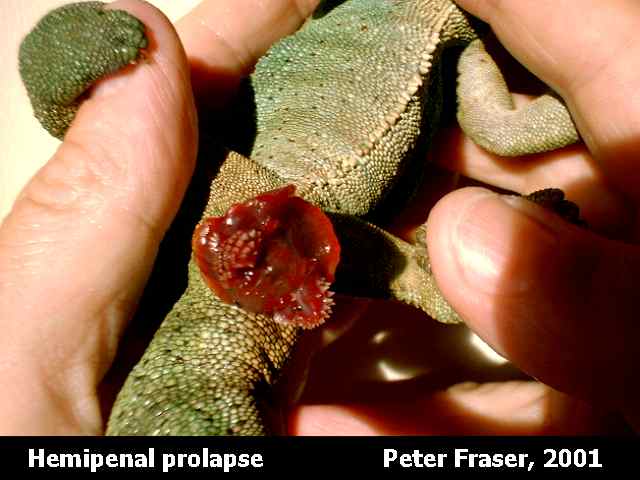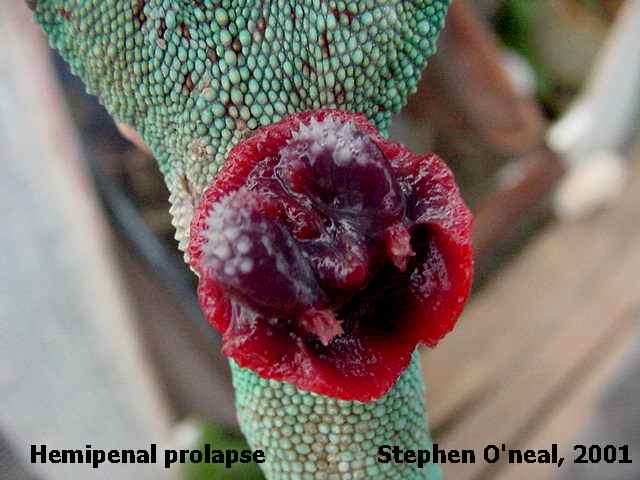 |
|
| Veterinary Article |
| Treatment of the Hemipenal Prolapse |
|
by Jean Pare, DVM
|
The term, "prolapse," refers to the displacement of an organ or tissue from it;s normal position. This is typically the result of the weakening of muscles and/or ligaments that normally serve to keep the organs or tissues in place. A prolapse is always cause for concern. Trauma to tissue results in the release of chemical mediators leading to edema and inflammation. The net result is swelling and pain. Swelling of the extruded hemipenes (plural of hemipenis) will mechanically, from sheer volume, prevent their retraction within the hemipenal pockets. There may also have been some damage to the retractor muscle, a band of smooth muscle fibers that retracts the hemipenes under normal circumstances. Further damage can occur when the swelling impairs venous return and eventually circulation is compromised, with hypoxemia and eventually ischemia (death of tissue from lack of oxygen support). Further trauma can also occur to the now exposed, swollen, inflamed hemipenes. This is not an easy situation and any prolapse should be considered a medical emergency.
|
 |
Any prolapsed structure (hemipenes or cloaca) must be kept absolutely clean, moist, and lubricated (e.g. with saline, K-Y jelly). A saline solution should be gently squirted over the surface of the hemipenes to help remove dirt and debris. The next step is to try to reduce the swelling. There are several treatment strategies and more than one can work. Hyperosmotic solutions (e.g., sucrose) applied to the prolapsed structure can draw extracellular fluids from edematous tissue. Cold compresses can reduce inflammation and stimulate vasoconstriction which will minimize edema. When some reduction in the swelling is achieved, manual reduction should be attempted. Black, or deep purple, or dry and crusty tissues are probably dead and should be amputated.
|
When reducing (replacing) a prolapse, the use of anesthesia SHOULD be encouraged as this is undoubtedly a painful procedure. Failure of a chameleon to react to a procedure does not mean it is not painful. Anesthesia is justified on simple humane grounds. While anesthesia comes with a risk, in my opinion it is minimal in an otherwise healthy chameleon for such a short procedure. I would use isoflurane. Any procedure that would be deemed painful for a human, should be treated as such in reptiles. An added bonus to anesthesia is that it minimizes the tenesmus (i.e., the sensation of the need to defecate) and straining efforts of the lizard to push the inflamed, delicate hemipenes out, and very much facilitates the reduction procedure. Prolapsed tissue are often fragile and will tear easily, especially if the prolapse is a recurrence or if the tissue has been prolapsed for awhile. To push the tissues back in, I use a non-sticky, smooth-surfaced implement. Q-tips may tear through such tissues and if I use them, I lubricate them heavily. I use the plastic caps of hypodermic needles, or small plastic blood collection tubes. A rectal thermometer may also be used for this purpose. Reduction starts at the base of the prolapsed tissues. Patience and persistence, along with a delicate touch are necessary. The reduction is a question of minutes.
|
 |
|
It is often advisable to place two monofilament nylon, horizontal mattress sutures across the vent. I will also usually instill a very small amount of cortisone/antibiotic (Panalog, Topagen) ointment in the sacs, only once, to help in reducing the inflammation. You need to be careful in putting medication in the cloaca (or hemipenal sacs) as it may be absorbed systemically. I know of at least two fungal infections of the hemipenal sacs that may cause complications. If trauma to the hemipenes or to one hemipenis was severe or extensive, or if tissues were torn when attempting reduction, a short course of systemic antibiotics also may be indicated. Rest and relaxation, are all you provide afterwards. If the prolapse recurs after removal of the sutures (I would leave them in for 48 hours), then your prognosis drops. If they stay in, the prognosis is good, but I would not breed that chameleon for a while. This is only one opinion as to how to handle the situation. The opinions of other veterinarians may differ.
|
|
|
| This page last updated on: Wednesday, November 27, 2002 |
© 2002-2005 ADCHAM.com
ADCHAM logo illustrated by Randy Douglas. Web site design by Look Design, Inc.
Do not reproduce or redistibute any of content of this web site without express written permission from the authors.
|
|
|
